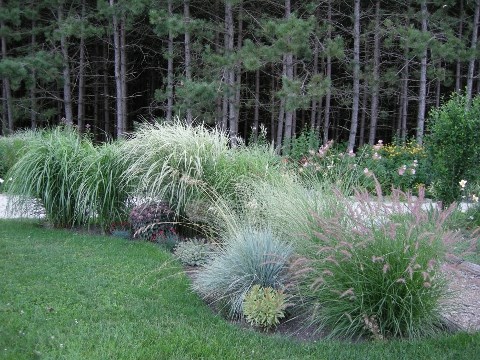
“Gardening is my passion,” says Lorraine Roberts. “It’s always been in my DNA.” Former recording artists Lorraine and RJ Roberts have plenty of experience making a living doing something they love. Over the course of their successful musical careers, gardening was a constant thread which grounded them and brought them together.
After purchasing their expansive creekside property, Roberts began growing thousands of perennials from seed. It was a joy for her to research the different varieties, acquire the seeds, and care for them until they were large enough to plant in the garden. “We used to joke that I was working on my retirement fund,” says Roberts.
Little did they realize how true that would become. As their recording careers were wrapping up in 2004, they looked around their property and realized they had so many potted plants needing dividing that it made sense to have a plant sale. It was a roaring success, with visitors to the garden declaring, “I’m in paradise!” The inspiration for their nursery and botanical garden was complete, and they devoted themselves full-time to their new endeavor.
Visit Plant Paradise Country Gardens on the web at http://www.plantparadise.ca/.
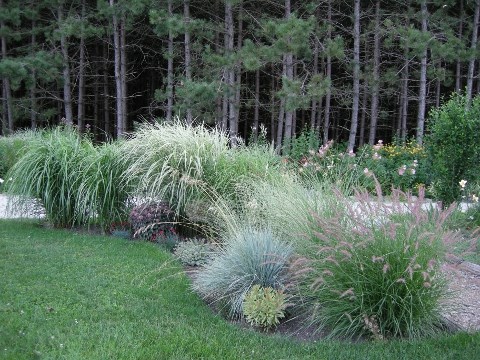
Photo by: Plant Paradise Country Gardens
From the start, Roberts knew she wanted the garden to be fully organic. Yet veteran gardeners know that without careful planning, keeping a 24-acre parcel free of invasive weeds and pests could be a full-time job. “Biodiversity is the key to our success,” says Roberts. “We use the natural defense of nature to take control.” By using a combination of native plants and well-adapted perennials, she invited wildlife such as birds, toads and frogs into the garden beds to eat unwanted insects and keep pests under control.
Roberts also credits a healthy soil with getting her plants off to a strong, pest-free start. “When planting, we dig the hole twice as wide as the root ball and add shrimp compost or manure, mixing it well. We also add more compost to the beds every year.” Compost has some nutrients, but to give plants an extra boost, she uses organic fertilizer. “We grow everything without the use of synthetic fertilizers,” she says. “Synthetic fertilizers are derived from the petroleum industry, and they can leave behind toxins such as petroleum, arsenic, and lead.” Instead, she uses an organic product with ingredients high in minerals such as greensand and glacial rock dust, along with the more common organic ingredients such as blood, bone, alfalfa, and kelp meals.
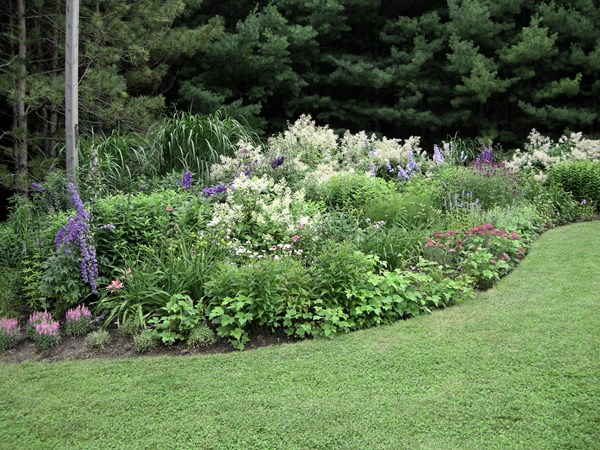
Photo by: Plant Paradise Country Gardens
Weeds are usually the biggest task in an organic garden, but Roberts’ planting strategies and low-fuss maintenance calendar keep them at bay with little stress. First of all, she designs each bed so plantings are full, but not crowding one another. There’s not a lot of open space for weeds to take hold. Then because of the snow cover all winter, she doesn’t need to start weeding until June. “I use my Hori Hori knife and hula hoe to get things done lickety-split, and as soon as I finish one bed, I apply corn gluten. It’s an all-natural product which stops the germination of all seeds,” she says. Corn gluten is effective both in the garden beds and on the lawn.
By July, she’s done weeding and can work on other projects. Though perennial flowers have a reputation for needing care and deadheading to keep the show going, Roberts designs her plantings carefully so she doesn’t have to deadhead at all. Because of that, she doesn’t need to focus on maintenance again until October or November when she does one more run through the garden, cutting back the perennials and weeding one more time. “I believe all gardens require some maintenance,” she says. “The key is keeping it manageable to the degree of time you’re willing to invest.”
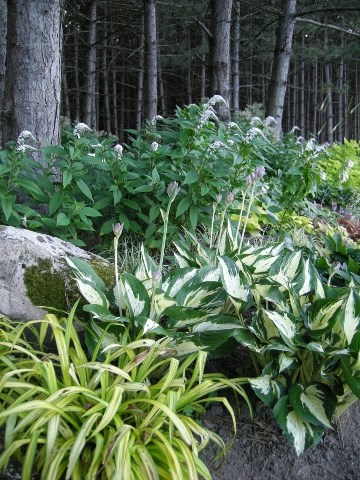
Photo by: Plant Paradise Country Gardens
Perennials are often thought to need a lot of water and fertilizer, but in Roberts’ garden, this doesn’t bear true at all. “When you sprinkle a little water for 20 minutes, the roots stay at the surface,” she explains. “The plants think, ‘I better stay at the top of the soil and wait for water!’” Instead, she trains the plant roots to grow deep into the soil where it is cool and moist by soaking plants thoroughly but infrequently. She waters perennials regularly until they are established, but after that they only get water during a severe dry spell.
She also credits her use of compost and mycorrhizal fungi with allowing her to take this tack. By applying compost yearly, there is a constant stream of organic matter which holds moisture in the soil. Mycorrhizal fungi naturally occur in the soil, and develop a symbiotic relationship with plants that allows roots to reach deeper and wider than they would ordinarily be able to. She sprinkles a mycorrhizal fungi treatment in the bottom of the hole when she plants to get things off to a good start.
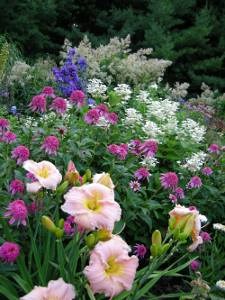
Photo by: Plant Paradise Country Gardens
Designing a garden with continuous blooms is one of the biggest goals of a perennial gardener. While many people rely on deadheading to encourage repeat bloom, Roberts simply doesn’t have time for that. Instead, she relies on supercharged plant selections which bloom from summer all the way through the end of the growing season. New favorites include Arizona Apricot blanket flower (Gaillardia ‘Arizona Apricot’), Meteor Yellow coneflower (Echinacea ‘Meteor Yellow’), and Big Bang Mercury Rising tickseed (Coreopsis ‘Mercury Rising’). By combining long-blooming perennials with those which flower in spring, such as Jack Frost Siberian bugloss (Brunnera ‘Jack Frost’) and Double Ellen Purple Lenten rose (Helleborus ‘Double Ellen Purple’), she creates a continuous stream of interest. Perennials with shorter bloom seasons add their color and change the overall feel of the beds throughout the season, so there is always something new happening.
To pump up that wow factor, Roberts advises massing plants. “Start with three of the same, then add another grouping over there – grouping always works because it gives the plants much more impact in the garden,” says Roberts. That said, there’s no need to adhere to hard and fast rules when putting together plant combinations in the garden. “People ask, ‘Oh, what should I do?’ and I say ‘It’s your garden – it’s about what you like, you have to enjoy it,’” she says. “There are no rules in the garden.”
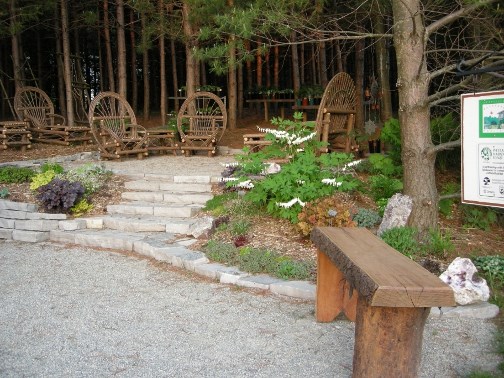
Photo by: Plant Paradise Country Gardens
Part of what makes this garden special is the way the flower and foliage combinations seem to harmonize so naturally with the rustic setting. Years before they owned the property it was a white pine and spruce plantation, so part of their journey in designing the display garden was figuring out the proper balance between natural and man-made. “We work with the actual surroundings,” Roberts says. “In the area near the creek, we only use native plants. I’ve been tempted to put daffodils, but I use Virginia bluebells and other native ephemerals instead.”
The plant choices aren’t the only place they give a nod to the countryside. RJ Roberts, Lorraine’s husband, makes rustic furniture out of the twisted stems of the dead black cherry trees found around the property. They chose cedar for swan chairs, arbors, and split rail fences, because the natural look of the wood is more in keeping with the surroundings than painted or man-made materials would be. Copper and brass weathervanes from the Smithsonian Collection add heritage appeal.
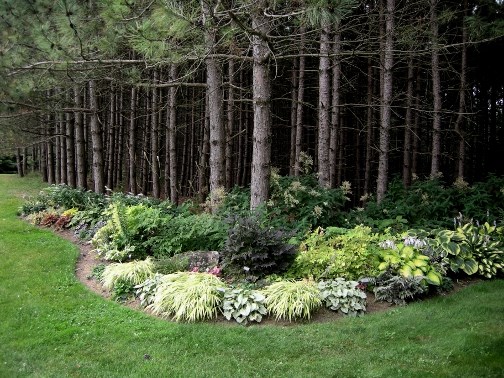
Photo by: Plant Paradise Country Gardens
Most of the perennial gardens have been built in front of the forest, so the trees act as a green backdrop to the blooms. However, in a few of the shadier beds, Roberts has had to deal with the issue of root competition from trees. “You can plant right next to a pine tree, but deciduous trees have much thirstier roots,” she says. “Deciduous trees will always win out because they sap all the water and nutrients from the area.” In places like this, proper plant choices become even more critical.
Hosta, groundcovering varieties of foamflower such as Tiarella cordifolia or T. ‘Cascade Creeper’, and sweet woodruff (Galium odoratum) are all tough enough to withstand the shade and lack of water found under many trees. Roberts also recommends planting bulbs, which can grow through a groundcover and provide extra color. “I planted some Japanese Jack-in-the-pulpit (Arisaema sikokianum) so they emerge from the sweet woodruff, and it just looks fabulous,” she says. “So there are opportunities there.” Little Beauty species tulips, native Jack-in-the-pulpit, and daffodils are other potential options.
In beds that are shaded by trees but have less of an issue with thirsty roots, the use of colored foliage to brighten the area is a great strategy. For example, in the bed pictured, Hillside Black Beauty snakeroot (Actaea ‘Hillside Black Beauty’) has chocolate-colored foliage which combines beautifully with Goldheart bleeding heart (Dicentra ‘Goldheart’) because the dark foliage recedes into the backdrop and adds depth to the bed, while light bounces off the bright golden leaves of the Dicentra and adds cheer. In the foreground, King’s Ransom Siberian bugloss (Brunnera ‘King’s Ransom’) and Japanese forest grass (Hakonechloa ‘Aureola’) provide additional color and textural contrast. The combination draws attention even when none of the plants are flowering.
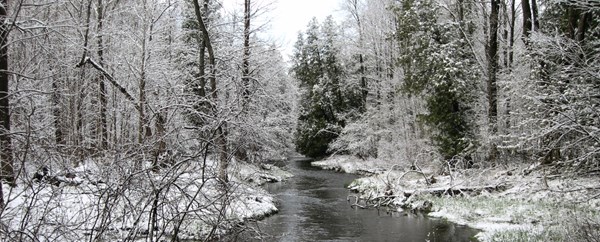
Photo by: Plant Paradise Country Gardens
Though perennials go dormant in winter, the snow-covered gardens are not without appeal. Roberts plants winter-interest shrubs as a foundation planting around her home and as a backdrop between the perennials and the trees. Red-twig dogwoods, golden globe-shaped cypress, Pinky Winky hardy hydrangea (Hydrangea ‘DVPpinky’), giant silver grass (Miscanthus giganteus), and a variety of junipers have a sculptural and colorful look when surrounded by snow.
That said, even without ornamentation the natural setting shines. “When surrounded by this many trees, it’s so beautiful with just the snow,” she says. “In rural and country gardens, snow is a blessing because it acts as a protective mulch.” Dragon arums and Agapanthus are two plants which aren’t usually hardy in that zone, but survive in the Roberts garden. The trees and snow cover shelter plants from the freeze/ thaw cycle which can be so damaging to tender species.
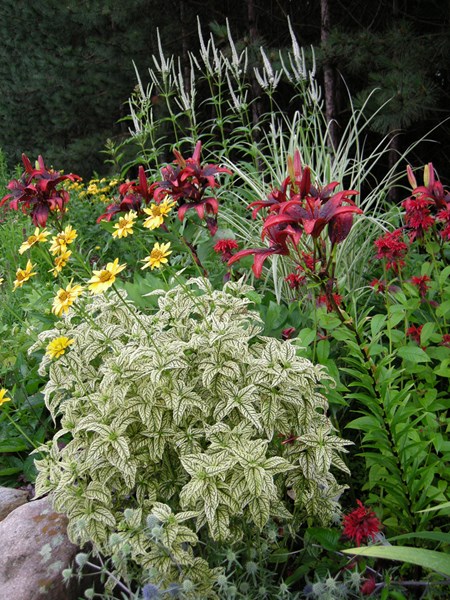
Photo by: Plant Paradise Country Gardens
When trying to design your own perennial garden, Roberts says the best way to start is by learning about all of the different plant choices for your zone and growing conditions. “Having extensive plant knowledge is like having an encyclopedia in your head,” she says. Knowing your plant options allows you to look at a space in the garden and think through all of the choices to find the best one. “Plants are the gardener’s palette, and you’re creating a painting that is never quite finished.”
Once you’re familiar with a wide variety of plants, think about creating contrasts with flower shape, texture, and color. “For example, Royal Candles speedwell (Veronica ‘Glory’) has a beautiful blue color and grows in a spire shape to 15 inches tall,” she says. “Ask yourself, what goes with that plant? PowWow Wild Berry coneflower (Echinacea ‘PAS702917’) combines well with it because the flowers are such a different shape. If you were to see the combination in a black-and-white picture, it would still hold your interest because of that contrast.”
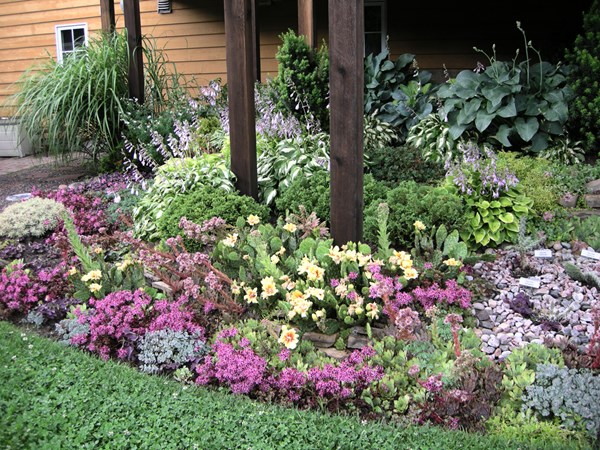
Photo by: Plant Paradise Country Gardens
When she’s creating and designing a garden, Roberts looks at it from an artist’s perspective. “It’s all about working with the natural surroundings, and that always guides me in choosing the right plants for the design,” she says. “There is so much to consider, such as the shape of the beds, the bloom shape, the color combinations, the foliage color, and the textures of plants.”
However, gardening isn’t just about aesthetics. “I really think nature brings us closer to our senses,” she says. “Gardens are always evolving and changing, and they are truly a metaphor for life. For a brief moment when we garden, we actually become co-creators, and it’s that impermanence of gardening that gives me a greater appreciation for every life experience.”
SOURCE:http://www.gardendesign.com/pictures/a-rustic-perennial-paradise_303/